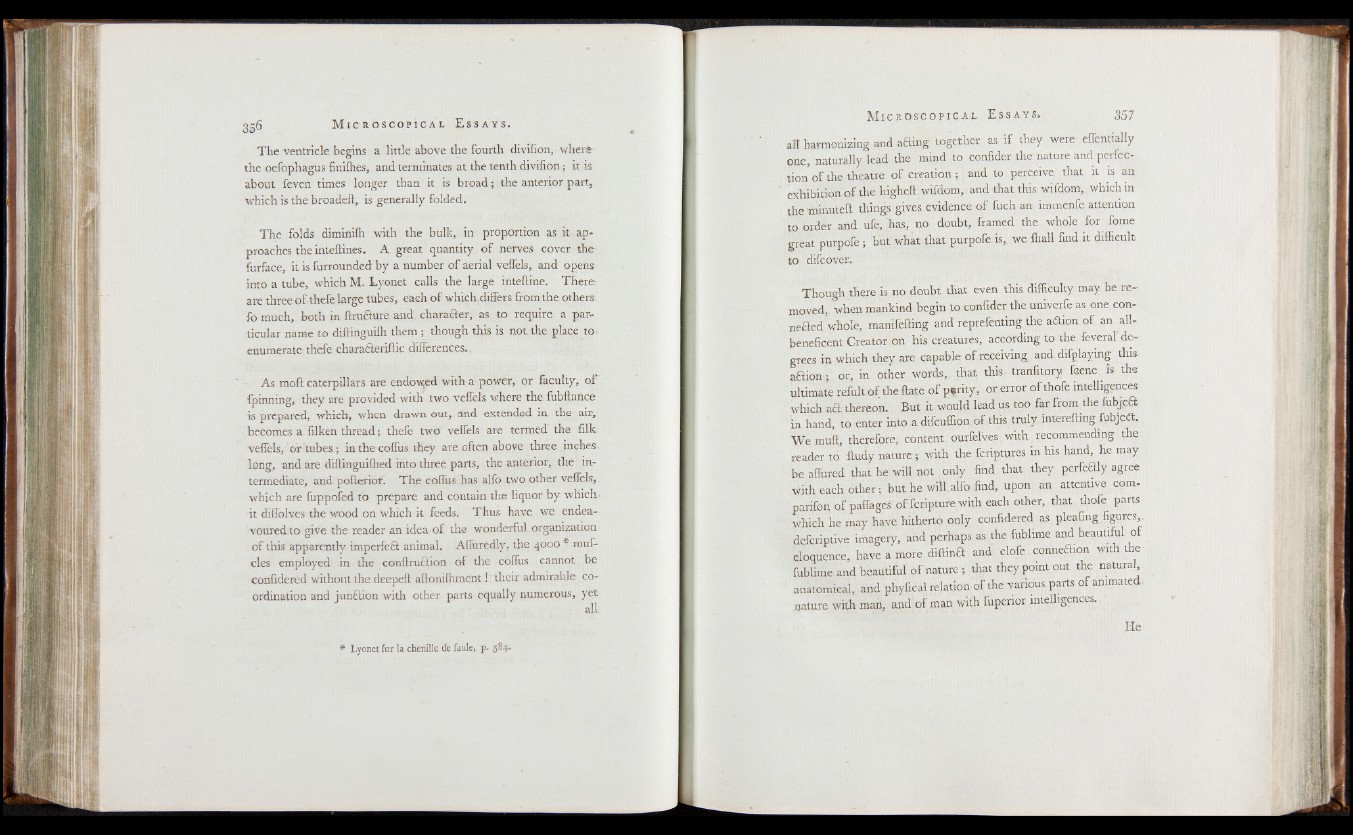
M 3S6 i c r o s c o p i c a l E s s a y s .
The ventriele begins a little above the fourth divifion, where
the oefophagus finilhes, and terminates at the tenth divifion; it is
about feven times longer than it is broad; the anterior part*
tvhich is the broadeft, is generally folded.
The folds diminifh with the bulk, in proportion as it approaches
the inteftines. A great quantity of nerves cover the
furface, it is furrounded by a number of aerial veflels, and opens
into a tube, which M. Lyonet calls the large inteftine. There
are three of thefe large tubes, each of which differs from the others,
fomuch, both in ftru&ure and character, as to require a particular
name to diftinguifh them ; though this is not. the place to
enumerate thefe charafleriflic differences..
As moft caterpillars are endowed with a power, or faculty, o f
fpinning, they are provided with' two veffels where the fubftance
is prepared, which, when drawn out, and extended in the air,
becomes a filken thread; thefe two veffels are termed the filk
veffels, or tubes ; in the coffus they are often above three inches;
long, and are diftinguifhed into three parts, the anterior, the intermediate,
and poflerioT. The coffus has alfo two other veffels,.
which are fuppofed to prepare and contain the liquor by which;
it diffolves the wood on which it feeds. Thus have we endea-
vourecLto give the reader an idea of the wonderful organization
o f this apparently imperfeft animal. Affuredly, the 4000 * muff
cles employed in the conftruHion of the coffus cannot be
confidered without the deepeft aftonifhment! their admirable coordination
and junction with other parts equally numerous, yet
# Lyonet fur la chenille d'e faule, p. 584.
all harmonizing and aiding together as if they were effentially
one, naturally lead the mind to confider the nature and perfection
of the theatre o f creation ; and to perceive that it is an
exhibition of the higheft wildom, and that this wifdom, which in
the ’minuteft things gives evidence o f fuch an immenfe attention
to order and ufe, has, no doubt, framed the whole for feme
great purpofe ; but what that purpofe is, we fhall find it difficult
to difcover.
Though there is no doubt that even this difficulty may be removed,
when mankind begin to confider the univerfe as one connected
whole, manifefting and reprefenting the adtion o f an. all-
beneficent Creator on his creatures, according to the feveral degrees
in which they are capable o f receiving and difplaying this
aaion ; or, in other, words, that this- tranfitory feene is the
ultimate refult of the ftate o f parity, or error of thofe intelligences
which a a thereon. But it would lead us too far from the fubjea
in hand, to enter into a difcuffion. of this truly intereftingfubjeft.
We mult, therefore, content ourfelves with recommending the
reader to ftudy nature; with the fcriptures in his hand, he may
beaffured that he will not only find that they perfectly agree
with each other; but he will.alfo find, upon an attentive comparifon
of paffages of fcripture with each other, that thofe parts
which he may have hitherto only confidered as pleafing figures,
defcriptive imagery, atid perhaps as the fublime and beautiful of
eloquence, have a more diftinft and clofe conneftion with the-
fublime and beautiful of nature ; that they point out the natural
anatomical, and phyfical relation of the various parts of animated,
nature with man, and of man with fuperior intelligences.
He